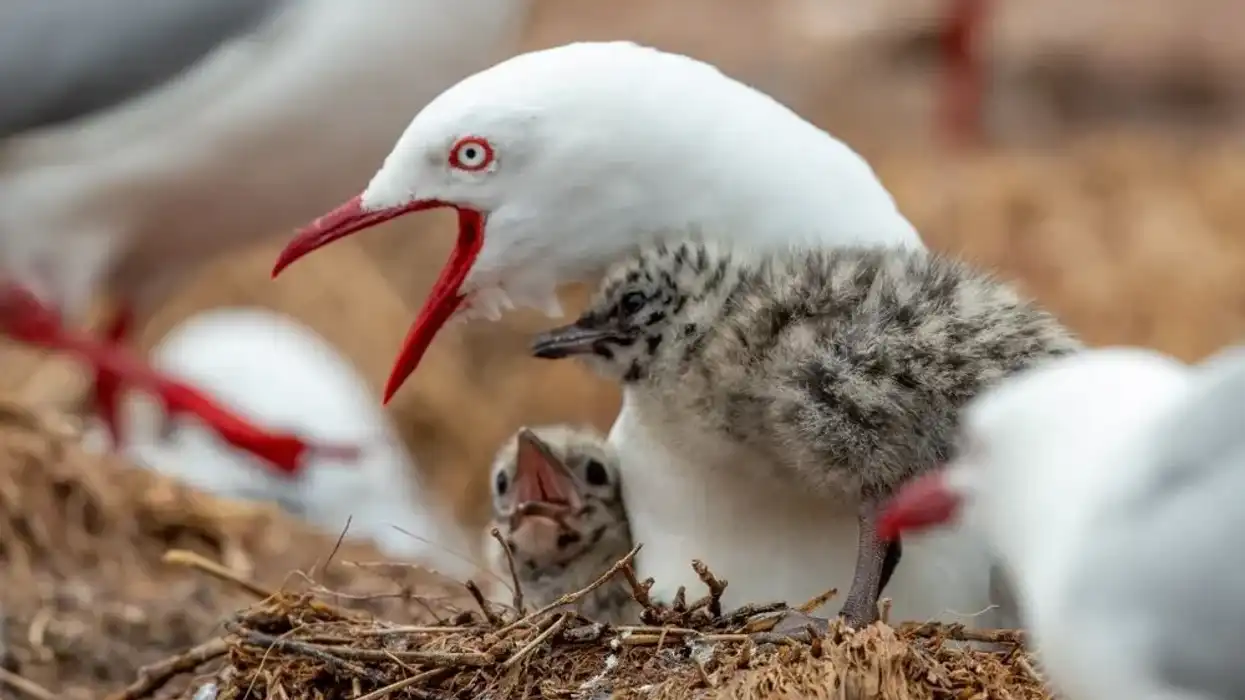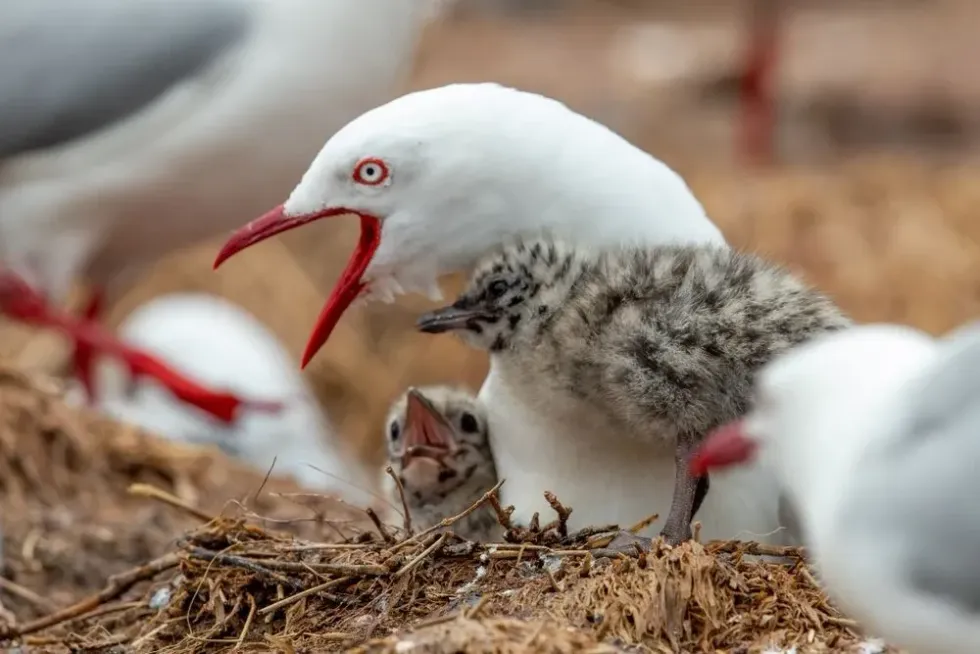Are you interested to know about birds like the Australian magpie? If yes, then you're in for a treat as we are going to learn about the red-billed gull that resides in New Zealand and other nearby islands.
This bird is a subspecies of the silver gull, and it's known for having a red bill. The rest of its body is predominantly white with black and white tips on the gray wings.
But, the young birds tend to have brown wing patches.
Like other gulls, it inhabits the coastal areas of the island and the adults form a colony when it's time to breed. The main food for this bird is krill, but it also feeds on small fish and earthworms.
Unfortunately, the population has been on the decline, so there's a need to conserve the birds so they can breed and sustain the numbers. So, keep reading to know more interesting red-billed gull facts.
Also, check out the articles on black-headed gull and glaucous gull to know about birds.
Red-Billed Gull Interesting Facts
What type of animal is a red-billed gull?
Red-billed gulls are a subspecies of the similar-looking silver gull (Chroicocephalus novaehollandiae) that's widely seen in Australia. These gulls are also known as mackerel gulls. However, in Māori, this species is called tarāpunga or akiaki.
What class of animal does a red-billed gull belong to?
Like other gulls, such as the kelp gull, the red-billed gull also belongs to the class Aves as well as to the family Laridae.
How many red-billed gulls are there in the world?
During the latest survey of the breeding colonies of New Zealand, researchers found only about 27,831 nesting pairs. The red-billed gull population is said to have declined a lot since the '60s, and the current estimate is anywhere around 500,000 individuals.
Where does a red-billed gull live?
The red-billed gull is native to New Zealand, and it's also found in the nearby Chatham Islands, and other subantarctic islands. You can find these birds in inland areas such as Lake Rotorua on the North Island of New Zealand.
What is a red-billed gull's habitat?
Like many other gull species, the red-billed gulls also like to inhabit the coastal areas of New Zealand. Some populations can also be seen in inland areas like lakes.
At times you can also find the birds in towns, especially when looking for food. During the breeding season, the birds can be seen in colonies near cliffs or rocky shores which form great places to build nests.
Who does red-billed gull live with?
Gulls usually reside in groups and share strong societal bonds. Along with that, the colonies tend to be quite strong and can claim a breeding area for a long time. These gulls are also monogamous in nature, so during the breeding season, you can find them in pairs before the nesting is over.
How long does a red-billed gull live?
Usually, the lifespan of these gulls is said to be around twelve years, but some adult birds have managed to reach the age of 30 years.
How do they reproduce?
One of the most interesting things about the red-billed gulls is reproduction. Like most other gull species, these birds form monogamous pairs that stay intact for several seasons.
The birds strengthen their relationship by participating in courtship feeding. Males feed the female birds during the courtship feeding.
Both birds take part in creating a strong nest out of seaweed, grasses, ice plants, and other leaves. In the mainland, you can find the gulls being a part of strong breeding colonies set up in rocky terrains, sandpits, islets, or cliffs. But, in islands, the birds may at times nest in scattered places away from other gulls.
The adult female lays about two eggs per clutch and the incubation lasts for around 24-27 days. The breeding season is said to be between September and January.
What is their conservation status?
Currently, one of the facts about red-billed gulls is that the International Union for Conservation of Nature (IUCN) classifies it under the status of Least Concern in the Red List.
Red-Billed Gull Fun Facts
What does the red-billed gull look like?
The most important thing about the red-billed gull has to be its look. By now, you must know that these birds have a red bill.
But, along with that, even the legs and feet are red. Though in immature birds, the legs, and the bill can be brown. Apart from that, most adults are covered in white feathers with black markings on the otherwise silver or pale gray wings with white tips.
Young birds have brown patches on the wingtips. Both sexes look pretty similar but the male has a stouter bill compared to the females.
When it comes to the difference between black-billed gull vs red-billed gull, the obvious one is the black bill present in the black-billed gull. Other than that, the bill of the black-billed gull is much longer than the red-billed gull. And, another difference lies in the feet, as those of the black-billed gull is reddish-black in color.

How cute are they?
Just like other gull species, these birds look extremely adorable because of the fluffy white feathers and red bill along with red legs and feet.
How do they communicate?
Communication in this bird is mainly through calls. The common calls include 'scrark and kwe-aaar', and these are often heard in a colony of birds.
The calls are often described as high-pitched and clattering. If the birds feel threatened, a 'kek' sound may be heard in a colony or even by an individual. During the breeding season, the frequency of calls increases and a colony can get pretty loud especially when females are about the lay eggs.
How big is a red-billed gull?
According to the usual description, the average size range of the red-billed gull is around 14.5 in (37 cm). Even though it's a fairly small species, males tend to be slightly bigger than females. In comparison, the Australian pelican has an average size range of 19.5 in (49 cm).
How fast can a red-billed gull move?
Even though we don't know the exact speed of these birds, we can assume that their speed is similar to the parent species of silver gulls. So, the flying speed should be around 18-22 mph (29-35.4 kph).
How much does a red-billed gull weigh?
The average weight description of this gull is around 8.4-11.2 oz (240-320 g). Australian magpies also weigh around the same with a weight range of 7.8-12.3 oz (220-350 g).
What are the male and female names of the species?
There are no separate names for the male and female of this species.
What would you call a baby red-billed gull?
A baby red-billed gull is known as a chick.
What do they eat?
The main food of the red-billed gull bird is krill, a small crustacean found in the natural habitat of these gulls. During the breeding season, you can find colonies of this bird feeding on surface swarming krill.
Other than that, these gulls can also feed on small fish, kelp flies, and earthworms. This bird is also known as an aggressive scavenger, so on the islands, it is often seen rummaging through any garbage that it can find.
This behavior of feeding has become a problem in the urban areas, where the birds may become a nuisance.
These birds have also been defined as kleptoparasite, so the gulls also have the habit of snatching and feeding prey from other birds or nearby areas. Very few times it has also been seen to feed on insects, berries, and lizards along with krill.
Are they dangerous?
In general, gulls would never really be dangerous to human beings. But, that isn't always the case especially when it's agitated or irritated for some reason.
Red-billed gulls are quite aggressive about protecting their breeding site, and you wouldn't like to get attacked by the bills of the adults as it can be quite sharp. If you are visiting the place where these birds dwell, make sure to follow the field guide to avoid getting into any problems.
Would they make a good pet?
No, the red-billed gulls are wild birds of the world that live in the coastal areas and aren't meant to be kept as pets. But, if you're visiting the areas where this species dwells, think about giving it some food.
Did you know...
Formerly, the red-billed gull (Larus scopulinus) was a thing, but since then, the bird has been identified as a subspecies of the silver gull, and the red-billed gull, Larus scopulinus has been changed to Chroicocephalus novaehollandiae scopulinus.
Breeding colonies may have up to 5,000 pairs of birds.
Are red-billed gulls endangered?
No, the red-billed gull endangered isn't a thing and the species is currently classified under the status of Least Concern. However, there has been a steep decline in the population so it's protected under the wildlife laws.
Are red-billed gulls native to New Zealand?
Yes, red-billed gulls are native to the islands of New Zealand. It is also one of the most common gull species present in New Zealand. Along with the country, these gulls are also found in neighboring places like the Chatham Islands and the other subantarctic islands.
Here at Kidadl, we have carefully created lots of interesting family-friendly animal facts for everyone to discover! For more relatable content, check out these laughing gull facts and ring-billed gull facts for kids.
You can even occupy yourself at home by coloring in one of our free printable seagull coloring pages.









